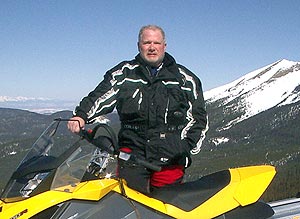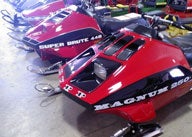Bassett’s Blog : Vintage Sleds A Threat?

There are reasons for growth of vintage sledding
At the peak of last week’s near-blizzard in central Minnesota, we stopped our sled ride to gather at a pit stop along the Soo Line trail.
As we parked our brand new (low mileage) 2007 test sleds outside the trailside restaurant; we noticed a couple of 1970s vintage Scorpions parked alongside the front edge of the parking lot. Both were in wonderful shape—especially considering that each was easily 35 years old. One hood had a nicely painted patriotic theme while the other retained historic Scorpion black paint on its scoop nose.
Upon entering the establishment, we noticed a couple of younger fellows—well, at least younger than me. One was outfitted in a Scorpion-logoed red and black hooded sweatshirt. The other had the Carhartt thing going for him. They were the owners/riders of the two Scorpions and they were of a similar—if not younger—vintage as their sleds. My riding partner, a veteran Scorpion enthusiast and former Scorpion factory racer, knew the lads. We struck up a conversation.
 Now, with no apologies, I will admit that this vintage thing has perplexed me some. I do get it. After all, I still have the 1969 Ski-Doo 320SS that was given to me one Christmas by my parents. And I still have one of the three 1964-65 10-horsepower Ski-Doo Olympiques that my dad sold the first year he was a snowmobile dealer. So, yes, I get the heritage and emotional side of vintage sleds. I don’t quite get why younger guys are so eager to ride and embrace vintage sleds.
Now, with no apologies, I will admit that this vintage thing has perplexed me some. I do get it. After all, I still have the 1969 Ski-Doo 320SS that was given to me one Christmas by my parents. And I still have one of the three 1964-65 10-horsepower Ski-Doo Olympiques that my dad sold the first year he was a snowmobile dealer. So, yes, I get the heritage and emotional side of vintage sleds. I don’t quite get why younger guys are so eager to ride and embrace vintage sleds.
The ‘Carhartt Guy’ said: “It’s kinda like riding a Harley for the snow.” Does that mean the sleds leak oil and ride hard? Yes and no!
His buddy said that he could invest a little money and get a long-term ride that put him in touch with what snowmobiling was all about. It sounded a little Thoreau, but what I think he meant was that even though his sled’s top speed was well under 50 miles per hour (the state speed limit in Minnesota, by the way), he enjoyed a sense of adventure of being a participant in winter.
Also, he pointed out, once he invested the hundreds or a few thousand dollars to get the vintage ride where he wanted it, he could have a nice sled for years to come. One that didn’t require huge repairs—since he could repair most of it himself. If he wanted to update the suspension, he could do it quite easily. Since these were older sleds and since Scorpion parts of those years were somewhat interchangeable, the lads could update the early Scorps with later Scorpion parts. The famed Para-Rail rear suspension could be added to virtually any older bogie model. The engine could be upgraded with newer and more reliable electronics and carbs could be switched out from Walbro to Mikuni.
While the guys liked working on the sleds to make them ‘theirs,’ they enjoyed riding them more. Interestingly, more and more younger riders are finding old sleds to enjoy. They are cheap compared to the US$10,000-plus required for today’s newer, heavier and more complex sleds. But, as ‘Carhartt Guy’ noted: “Parts for the old sleds are getting harder to find and more expensive as more people are getting into vintage.”
Indeed, more people are getting into older sleds. While we were at the pit stop, another small group came in. One of the younger fellows climbed off a John Deere, the old silver and green one.
With the reality that vintage snowmobiling is growing in popularity, how does this impact the existing sled makers? Is there a realization by today’s snowmobiling crowd that today’s sleds are too expensive for the length of the season? Is there a feeling that today’s sleds are just too heavy and way too complicated? Is there a growing insider club of vintage sleds—like there is with street rodders, classic car buffs and, yes, Harley guys—where you can be an individual with a remade sled customized to you by you that has greater appeal than the sled makers realize?
When we went to Eagle River, Wis. for the races this past January, we were impressed with how big vintage sled racing has become. Over the years, I covered many of those sleds that I was now seeing compete in the vintage events at Eagle River. The difference is that the vintage sleds weren’t falling apart and leaving debris all over the historic oval as the originals had done. And today’s vintage sled racers are actually better overall drivers on average than many of the old time competitors. Vintage racing is impressive. And growing.
As one aftermarket pioneer told me: “If you put a few thousand dollars into building up a vintage race sled, you could race that sled for years. But if you race the new sleds, to be competitive you have to get a new one every year.”
As new sleds get more expensive, more complicated, less mechanic friendly and much heavier, vintage sleds may pose a threat to new sled sales. Vintage sleds are simple, fun and can be made quite reliable. When your butt is a foot off the snow rebounding from a bogie wheel suspension and cradled in a modest foam seat, the vintage sled’s 40 miles per hour top speed seems like a 100 mph on a modern sled. You experience winter first hand on a vintage sled. That’s part of the secret to the growth of vintage sledding.







 Your Privacy Choices
Your Privacy Choices